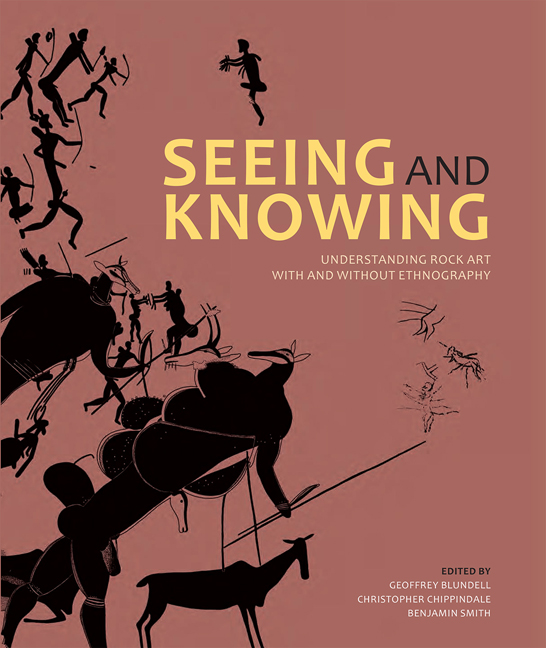Book contents
- Frontmatter
- Dedication
- Contents
- Contributors
- Acronyms
- Chapter 1 Rock art with and without ethnography
- Chapter 2 Flashes of brilliance: San rock paintings of heaven's things
- Chapter 3 Snake and veil: The rock engravings of Driekopseiland, Northern Cape South Africa
- Chapter 4 Cups and saucers: A preliminary investigation of the rock carvings of Tsodilo Hills, northern Botswana
- Chapter 5 Art and authorship in southern African rock art: Examining the Limpopo-Shashe Confluence Area
- Chapter 6 Archaeology, ethnography, and rock art: A modern-day study from Tanzania
- Chapter 7 Art and belief: The ever-changing and the never-changing in the Far west
- Chapter 8 Crow Indian elk love-medicine and rock art in Montana and Wyoming
- Chapter 9 Layer by layer: Precision and accuracy in rock art recording and dating
- Chapter 10 From the tyranny of the figures to the interrelationship between myths, rock art and their surfaces
- Chapter 11 Composite creatures in European Palaeolithic art
- Chapter 12 Thinking strings: On theory, shifts and conceptual issues in the study of Palaeolithic art
- Chapter 13 Rock art without ethnography? A history of attitude to rock art and landscape at Frøysjøen, western norway
- Chapter 14 ‘Meaning cannot rest or stay the same’
- Chapter 15 Manica rock art in contemporary society
- Chapter 16 Oral tradition, ethnography, and the practice of north American archaeology
- Chapter 17 Beyond rock art: Archaeological interpretation and the shamanic frame
- List of figures
- List of tables
- List of publications by david Lewis-williams
- Index
Chapter 4 - Cups and saucers: A preliminary investigation of the rock carvings of Tsodilo Hills, northern Botswana
Published online by Cambridge University Press: 21 April 2018
- Frontmatter
- Dedication
- Contents
- Contributors
- Acronyms
- Chapter 1 Rock art with and without ethnography
- Chapter 2 Flashes of brilliance: San rock paintings of heaven's things
- Chapter 3 Snake and veil: The rock engravings of Driekopseiland, Northern Cape South Africa
- Chapter 4 Cups and saucers: A preliminary investigation of the rock carvings of Tsodilo Hills, northern Botswana
- Chapter 5 Art and authorship in southern African rock art: Examining the Limpopo-Shashe Confluence Area
- Chapter 6 Archaeology, ethnography, and rock art: A modern-day study from Tanzania
- Chapter 7 Art and belief: The ever-changing and the never-changing in the Far west
- Chapter 8 Crow Indian elk love-medicine and rock art in Montana and Wyoming
- Chapter 9 Layer by layer: Precision and accuracy in rock art recording and dating
- Chapter 10 From the tyranny of the figures to the interrelationship between myths, rock art and their surfaces
- Chapter 11 Composite creatures in European Palaeolithic art
- Chapter 12 Thinking strings: On theory, shifts and conceptual issues in the study of Palaeolithic art
- Chapter 13 Rock art without ethnography? A history of attitude to rock art and landscape at Frøysjøen, western norway
- Chapter 14 ‘Meaning cannot rest or stay the same’
- Chapter 15 Manica rock art in contemporary society
- Chapter 16 Oral tradition, ethnography, and the practice of north American archaeology
- Chapter 17 Beyond rock art: Archaeological interpretation and the shamanic frame
- List of figures
- List of tables
- List of publications by david Lewis-williams
- Index
Summary
Throughout Africa in at least 22 countries and even further afield are rocks with clusters of enigmatic pecked or drilled hemispherical hollows and/or rocks with ground-out grooves. It is probable that these carvings are much more common than realised, but they have often been ignored because of their ambiguity, lack of iconicity or because it is often thought that they are natural or mundane manufacturing tools. For example, copies or photographs of petroglyphs of animals and other subject matter in southern Africa often include dimple-like depressions or groove-like dashes or scratches that have seldom been commented on by the researchers (e.g. Wilman 1933; Fock 1979; but see Ouzman 2001). These carvings recall the hollows that may form on hammerstones or anvilstones, on the one hand, and grooves on whetstones for sharpening tools such as arrowpoints and axe- or adze-heads, on the other; indeed, their simple form probably has contributed to many being classified as ‘utilitarian’. However, the wear, shape, lack of associated waste from manufacturing or processing, context and arrangement or placement suggest other - wise for many. It seems that several may have served as religious symbols or been the ‘non-utilitarian’ byproducts of ritual activity, or perhaps included magical concepts in their use. Their frequency and size and the amount of effort put into their production certainly allude to their importance. Their simplicity and lack of iconicity, and the absence of any discernible meaningful patterning or syntax in their creation, suggest that they are not obviously examples of art as we understand it, especially when compared with rock paintings where the use of pigment clearly indicates an element of intentional symbolic design. Yet many appear to have served similar symbolic functions and so they are collectively regarded here as a form of rock art for convenience.
This chapter looks at these issues in an introductory examination of the carvings at Tsodilo Hills in northwest Botswana, where they are particularly common.
- Type
- Chapter
- Information
- Seeing and KnowingUnderstanding Rock Art With and Without Ethnography, pp. 54 - 73Publisher: Wits University PressPrint publication year: 2010



